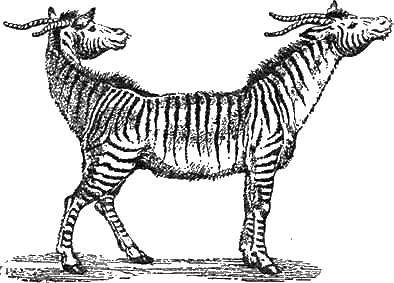Pushmi-Pullyu
The pushmi-pullyu is an animal character from Hugh Lofting’s children’s book “The Voyage of Dr. Doolittle.” The pushmi-pullyu is a “cross between a gazelle and a unicorn” and it has two heads – one at each end of its body. According to Wikipedia, “the pushmi-pullyu usually only uses one of its heads to talk, reserving the other for eating (thus allowing it to eat while speaking without being rude) and claims that its great-grandfather was the last unicorn.”
As its name suggests, there would appear to be the potential for conflict if the two heads differ in their intention as to which direction to move. Even if the heads agree to move in the same direction, one head could differ in its inclination as to how fast it should be getting there. Strange as it may seem, this image allows me to gracefully segue into a situation some conveyor folks can have when using two Pulserollers mechanically linked together in the same conveyor zone when using ConveyLinx ERSC. It’s easy enough to get the rollers to go in the same direction – you simply Auto-Configure the zone with one sensor and connect the two rollers and both rollers logically rotate in the same direction. And, as a lot of conveyor applications go, you probably also want to control the speed by using Closed Loop control with the ERSC. The rub, so to speak, can occur when the rollers are mechanically linked, let’s say with a belt.
 Common sense would dictate that you go to EasyRoll and put both rollers in Closed Loop and set them to the exact same speed and you are done. If you do this with your belted (or otherwise mechanically linked) zone, there is a possibility that in a short while you’ll see the zone not working and when you examine the ERSC in EasyRoll you may see one of the rollers indicating an “overheat” condition. Here’s the weird part – you touch both rollers and they are not hot – or at least not 100° C kind of hot as they would be for a real overheat condition. What gives?
Common sense would dictate that you go to EasyRoll and put both rollers in Closed Loop and set them to the exact same speed and you are done. If you do this with your belted (or otherwise mechanically linked) zone, there is a possibility that in a short while you’ll see the zone not working and when you examine the ERSC in EasyRoll you may see one of the rollers indicating an “overheat” condition. Here’s the weird part – you touch both rollers and they are not hot – or at least not 100° C kind of hot as they would be for a real overheat condition. What gives?
Well, here is where the pushmi-pullyu comes in. Because you are using closed loop control on each roller, the ERSC is using motor pulses for acceleration and deceleration as well as to maintain speed. What can happen is that one motor is “fighting” the other – most likely over-driving one of the motors during acceleration and/or deceleration. When this happens, it turns the DC motor into a generator. At the ERSC, it detects “negative current” coming from one of its motors. This is not a normal condition and the algorithm does not want to assume that “negative current” means “small current” because it only knows that it is “negative” – it does not know “how much negative.” Thus, the control assumes it’s a bad situation and kicks in the overheat protection functionality.
The solution is to get the two heads of the pushmi-pullyu on the same page: one of them does the talking and the other one does the eating. You do this by keeping the discharge end roller in closed loop speed control (i.e., the “talking” end) and change the in-feed end roller to open loop control (i.e., the “eating” end). With EasyRoll, you then jog the zone and monitor the current going to each motor. You adjust the speed of the open loop motor such that it draws about the same current (but a little less) than the closed loop motor. If you make the speed of the open loop motor too high it will overdrive the closed loop motor and put you back into the overheat situation. If you set the open loop motor too slow, it won’t be providing much help (which is its intended function in the first place, eh?). With the open loop motor’s speed adjusted so that its current draw is more or less the same as the closed loop motor, this indicates that they are properly sharing the load and one is not appreciably over driving the other. The only other thing to look out for is to possibly adjust the open loop motor’s acceleration/deceleration values to “roughly visibly” match the closed loop’s acceleration/deceleration.
Now with your two-headed conveyor zone properly talking and eating at the same time and not being rude to the rest of the conveyors, all is well. Now if I could only talk to animals, then that would really be something. But that’s for another article, someday.
